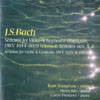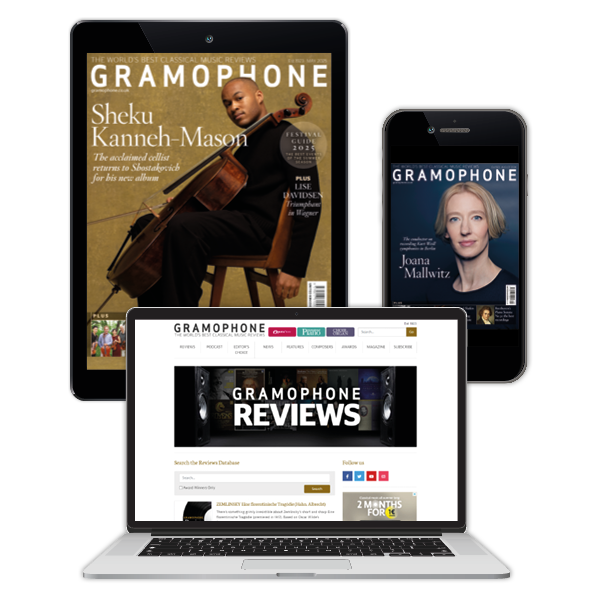Bach Violin & Keyboard Sonatas, Volume 3
These thoughtful and finely nuanced Bach sonata readings entirely fulfil the high expectations raised by the first instalment
View record and artist detailsRecord and Artist Details
Composer or Director: Johann Sebastian Bach
Label: Meridian
Magazine Review Date: 3/2001
Media Format: CD or Download
Media Runtime: 73
Mastering:
DDD
Catalogue Number: CDE84420

Tracks:
| Composition | Artist Credit |
|---|---|
| (6) Sonatas for Violin and Harpsichord, Movement: No. 5 in F minor, BWV1018 |
Johann Sebastian Bach, Composer
Johann Sebastian Bach, Composer Morey Ritt, Piano Ruth Waterman, Violin |
| (6) Sonatas for Violin and Harpsichord, Movement: No. 6 in G, BWV1019 |
Johann Sebastian Bach, Composer
Johann Sebastian Bach, Composer Morey Ritt, Piano Ruth Waterman, Violin |
| Sonata for Violin and Harpsichord, Movement: Adagio |
Johann Sebastian Bach, Composer
Carole Presland, Piano Johann Sebastian Bach, Composer Ruth Waterman, Violin |
| Sonata for Violin and Harpsichord, Movement: Cantabile |
Johann Sebastian Bach, Composer
Carole Presland, Piano Johann Sebastian Bach, Composer Ruth Waterman, Violin |
| (6) Sonatas for Violin and Continuo, Movement: No. 2 in G, BWV1021 (c1721) |
Johann Sebastian Bach, Composer
Carole Presland, Piano Johann Sebastian Bach, Composer Ruth Waterman, Violin |
| (6) Sonatas for Violin and Continuo, Movement: No. 4 in E minor, BWV1023 (c1717) |
Johann Sebastian Bach, Composer
Carole Presland, Piano Johann Sebastian Bach, Composer Ruth Waterman, Violin |
Author: Lindsay Kemp
Ruth Waterman and Morey Ritt have not exactly rushed to complete their recording of the Bach violin sonatas on modern violin and piano, and why should they have done? The disc containing the first four of the six sonatas for obbligato keyboard and violin appeared three years ago (12/97), and bespoke nothing less than the utmost care and forethought. ‘Churned out’ they certainly were not. The follow-up, offering the last two ‘obbligato’ sonatas plus the two alternative movements for Sonata No 6 and the two sonatas for violin and continuo (these extras featuring a change of pianist in Carole Presland), is no less lovingly prepared. All the elements that were so enjoyable in that movingly sculpted first release are present here, too: the intensely felt but never heavy-handed lyricism; the lithe, rhythmic buoyancy in faster movements; the meticulous attention to local details of dynamic and articulation; and the long-range shaping created by involving crescendos and diminuendos, sometimes extending with outstanding success over a sequence of movements, as in Sonata No 6’s progression from the surprisingly subdued solo keyboard third- movement Allegro, through the halting phrases of the Adagio to the measured but steadily mounting joyousness of the final Allegro.
Waterman’s booklet-notes show her approach to the music to be in many ways an unashamedly romantic and personalised one – eg in the Adagio of Sonata No 5 ‘the result is a feeling of profound resignation, and as the inevitable progression continues, one may become slowly aware of the presence of holiness’ – but so intelligent are these performances, so alert to the fertile discourse of Bach’s music, that there is not the slightest danger of them becoming swamped by old-fashioned sentimentalism or misplaced grandeur.
The texture is always clear, with the piano a full partner in the balance, and vibrato is used just enough to warm the tone (although the overall recorded sound in the continuo sonatas, presumably dating from a different session, is nevertheless somewhat cold). Occasionally the piano does not quite match the subtlety of the violin, and there are movements that can seem rather choppy. But this is very fine Bach-playing none the less. The sense of stillness and concentration in movements such as the Adagio of Sonata No 5 is unforgettable.'
Waterman’s booklet-notes show her approach to the music to be in many ways an unashamedly romantic and personalised one – eg in the Adagio of Sonata No 5 ‘the result is a feeling of profound resignation, and as the inevitable progression continues, one may become slowly aware of the presence of holiness’ – but so intelligent are these performances, so alert to the fertile discourse of Bach’s music, that there is not the slightest danger of them becoming swamped by old-fashioned sentimentalism or misplaced grandeur.
The texture is always clear, with the piano a full partner in the balance, and vibrato is used just enough to warm the tone (although the overall recorded sound in the continuo sonatas, presumably dating from a different session, is nevertheless somewhat cold). Occasionally the piano does not quite match the subtlety of the violin, and there are movements that can seem rather choppy. But this is very fine Bach-playing none the less. The sense of stillness and concentration in movements such as the Adagio of Sonata No 5 is unforgettable.'
Discover the world's largest classical music catalogue with Presto Music.

Gramophone Digital Club
- Digital Edition
- Digital Archive
- Reviews Database
- Full website access
From £8.75 / month
Subscribe
Gramophone Full Club
- Print Edition
- Digital Edition
- Digital Archive
- Reviews Database
- Full website access
From £11.00 / month
Subscribe
If you are a library, university or other organisation that would be interested in an institutional subscription to Gramophone please click here for further information.




